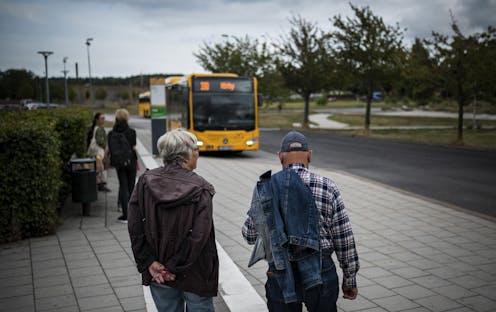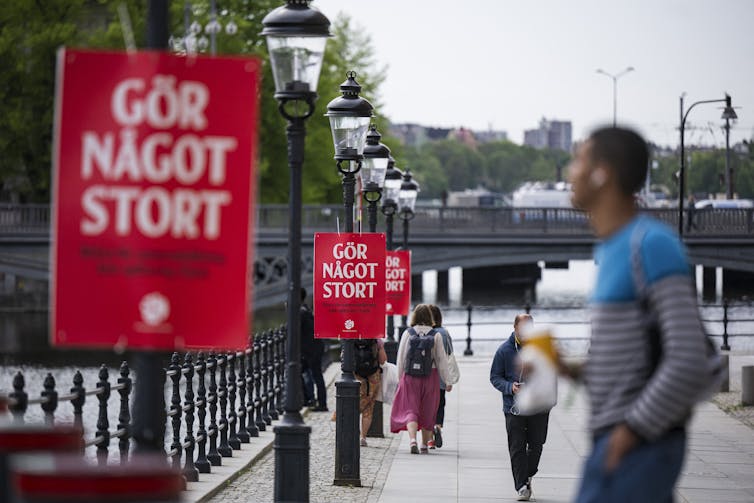Emigration: The hidden catalyst behind the rise of the radical right in Europe’s depopulating region
Researchers find a relationship between population declines in rural areas and support for populist radical right parties in 28 EU countries.

Earlier this spring, the European Parliament voted to overhaul its immigration policy to more evenly distribute responsibility among member states for managing the arrival of migrants and asylum-seekers.
Lurking in the details of the agreement, however, are provisions allowing for payments to third countries to block the entry of asylum-seekers to Europe – and, more ominously, preliminary plans for mass deportations.
Clearly, the EU’s dominant parties hear the footsteps of the anti-immigrant, populist right-wing parties, which are expected to make significant inroads in the EU Parliament elections June 6-9, 2024, and seek to reduce their appeal with stricter limits to those permitted to settle in Europe.
The idea of recapturing voters by appearing tough on immigration is attractive to established parties, but, as scholars of comparative politics and political behavior, we believe that this strategy won’t return many votes.
Younger voters leaving the countryside
While it is commonly held that the electoral success of far-right parties is due to a backlash against newcomers, all this focus on immigration obscures another potent force behind this trend: emigration, or the movement of people out of a region or country.
In a recently published study, our research team found a relationship between out-migration from counties and an increase in votes for populist radical right parties in 28 European countries during the mid-2010s.

Out-migration follows a familiar trend across the globe. As countries transition to postindustrial economies, younger generations leave the countryside and small towns for larger metropolitan areas seeking better educational and career opportunities. This phenomenon is especially prevalent in Spain, which has lost 28% of its rural population in the past 50 years. Facing similar declines, Italy recently resorted to paying people to move to its emptying villages.
Counties across the United States are also witnessing precipitous population loss due to a combination of low fertility and out-migration.
But while many people are aware of the economic ramifications this population flight creates, its impact on voters has been explored far less.
Rise of Sweden’s radical right
The case of Sweden illustrates how out-migration can benefit radical right populists. From 2000 to 2020, the country’s immigrant population increased from 11% to nearly 20%. During this time, over half of all Swedish municipalities experienced population decline as people moved to the country’s major cities of Stockholm, Malmö and Gothenburg.
Long dominated by centrist and center-left politics, Sweden is also witnessing a remarkable partisan shift.
The country’s oldest and largest party, the Social Democratic Party, has seen a gradual decline in popularity. Meanwhile, the populist, anti-immigrant Sweden Democrats, once considered a fringe group with a fascist past, have made significant gains and now hold a fifth of the seats in the national Parliament.
As a result, the country is now governed by a center-right minority coalition that depends on the support of the radical right populists.
While immigration is a key political issue for the Sweden Democrats, our research found growing support for the party in areas relatively unaffected by immigration. In fact, looking at elections over two decades, we found that it was in municipalities that lost population that the radical right was able to score big gains.
What’s more, local immigration was much less of a factor behind this success compared with local out-migration. Tracking five election cycles, we found a persistent gain of half a percentage point in vote share for the Sweden Democrats for every 1% loss in local population – a significant pace over the long term.
Political leanings in depopulating regions
Two key forces explain these dynamics. First, as many studies have shown, the people who move from the periphery to urban areas are more likely to lean left. With their departure, the remaining pool of voters naturally contains a greater proportion of conservatives than before. But composition of the electorate is only part of the story.

The political leanings of voters in depopulating regions also changed, from center-left to populist right. Here, emigration played a key role. As communities lose more and more of their working-age population, they experience a decline in public services – due both to dwindling numbers and a shrinking tax base. As a result, schools and hospitals are shuttered, public transportation is cut and local businesses close.
Along with these quality-of-life declines, living in a place that so many people choose to leave generates a sense of status loss among those who stay. Our interviews with Social Democratic Party leaders revealed how local mayors felt they had to contend with a “collective depression.”
One mayor noted: “We like it here. But then someone comes from the outside and says that you’re a failure if you live here … so we are struggling against the public perception of what constitutes a successful individual. We constantly have to work on the psychology of the municipality’s inhabitants.”
Meanwhile, disillusionment with established parties provides fertile ground for radical right parties to exploit.
Quality-of-life declines
While centrist politicians may feel compelled to adopt anti-immigrant stances in response, copying the rhetoric of radical right parties risks alienating their base.
Further, we believe cracking down on immigration is likely to prove an ineffective political strategy in the long run. The Sweden Democrats’ success in depopulating regions is in part a protest against the political establishment.
But once in office, and without clear solutions to the local economic and quality-of-life declines that emigration has set in motion, party officials will likely face the same voter discontent fueling their current success.
Ironically, the forces that have increased the appeal of the far right’s anti-immigrant ideologies – falling birth rates, labor shortages and a lack of new businesses and services – are most feasibly addressed by increasing immigration.
By following the right’s lead to tighten borders, parties closer to the center may condemn industrialized nations to a political doom loop.
Instead, centrist parties may find it pays more dividends to focus attention on addressing the root causes of population decline and restoring public services in peripheral areas.
There are some examples of this already happening. During recent years, Swedish governments have introduced and gradually expanded a national support system for local commercial services, such as grocery stores, in vulnerable and remote locations. In 2021, Spain announced a US$11.9 billion plan aimed at addressing the lack of 5G telephone connectivity and technologically smart cities in rural areas.
Meanwhile, the European Agricultural Fund for Rural Development is putting over $100 billion toward efforts to support rural areas in its 2021-2027 budget.
Such moves may counter a somewhat paradoxical trend that has seen fiercely anti-immigrant parties gaining ground in places least affected by immigration.
Either way, as parties in Europe and the U.S. prepare for crucial elections this year, understanding the complex interplay of demographic shifts and political dynamics is critical. As is acknowledging that emigration, often overshadowed by immigration rhetoric, is a key factor shaping the rise of the radical right.
The authors do not work for, consult, own shares in or receive funding from any company or organization that would benefit from this article, and have disclosed no relevant affiliations beyond their academic appointment.
Read These Next
RFK Jr. wants to scrutinize the vaccine schedule – but its safety record is already decades long
Federal officials are questioning the safety of the vaccine series children receive. Here’s the story…
Deception and lies from the White House to justify a war in Venezuela? We’ve seen this movie before
Two US wars based on lies, in which tens of thousands of American troops and millions of civilians died,…
Miami’s new mayor faces a housing affordability crisis, city charter reform and a shrinking budget
Eileen Higgins won a hard-fought election to become Miami’s new mayor. Now for the hard part – governing…






